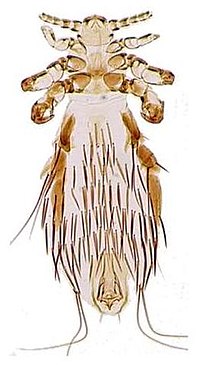
Photo from wikipedia
Simple Summary New sequencing technologies have now made it possible to sequence entire genomes for a diversity of life on earth. Parasites comprise nearly half of all species. Lice are… Click to show full abstract
Simple Summary New sequencing technologies have now made it possible to sequence entire genomes for a diversity of life on earth. Parasites comprise nearly half of all species. Lice are one important group of parasites of birds and mammals, including humans. Genome sequencing approaches have been applied to this group of parasites to uncover patterns of diversification. These patterns can be compared to the patterns of diversification in their hosts. Key findings from these studies have revealed that parasitic lice likely originated on birds and then switched to mammals multiple times. Within groups of birds and mammals, the evolutionary trees of lice match those for mammal hosts more than those for birds. Genomic approaches have also revealed that individual birds and mammals harbor distinct populations of lice. Thus, these new techniques allow for the study of patterns of diversification at a wide variety of scales. Abstract Next-generation sequencing technologies are revolutionizing the fields of genomics, phylogenetics, and population genetics. These new genomic approaches have been extensively applied to a major group of parasites, the lice (Insecta: Phthiraptera) of birds and mammals. Two louse genomes have been assembled and annotated to date, and these have opened up new resources for the study of louse biology. Whole genome sequencing has been used to assemble large phylogenomic datasets for lice, incorporating sequences of thousands of genes. These datasets have provided highly supported trees at all taxonomic levels, ranging from relationships among the major groups of lice to those among closely related species. Such approaches have also been applied at the population scale in lice, revealing patterns of population subdivision and inbreeding. Finally, whole genome sequence datasets can also be used for additional study beyond that of the louse nuclear genome, such as in the study of mitochondrial genome fragmentation or endosymbiont function.
Journal Title: Life
Year Published: 2022
Link to full text (if available)
Share on Social Media: Sign Up to like & get
recommendations!